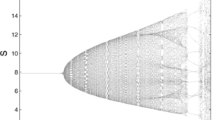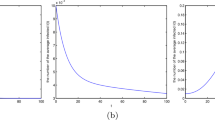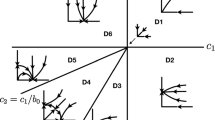Abstract
In this paper, the dynamic behaviors of a discrete epidemic model with a nonlinear incidence rate obtained by Euler method are discussed, which can exhibit the periodic motions and chaotic behaviors under the suitable system parameter conditions. Codimension-two bifurcations of the discrete epidemic model, associated with 1:1 strong resonance, 1:2 strong resonance, 1:3 strong resonance and 1:4 strong resonance, are analyzed by using the bifurcation theorem and the normal form method of maps. Moreover, in order to eliminate the chaotic behavior of the discrete epidemic model, a tracking controller is designed such that the disease disappears gradually. Finally, numerical simulations are obtained by the phase portraits, the maximum Lyapunov exponents diagrams for two different varying parameters in 3-dimension space, the bifurcation diagrams, the computations of Lyapunov exponents and the dynamic response. They not only illustrate the validity of the proposed results, but also display the interesting and complex dynamical behaviors.
Similar content being viewed by others
References
J. Satsuma, R. Willox, A. Ramani, et al., Extending the SIR epidemic model, Physica A, 2004, 336(3–4): 369–375.
M. E. Alexander and S. M. Moghadas, Periodicity in an epidemic model with a generalized nonlinear incidence, Mathematical Biosciences, 2004, 189(1): 75–96.
H. L. Liu, J. Y. Yu, and G. T. Zhu, Global asymptotic stable eradication for the SIV epidemic model with impulsive vaccination and infection-age, Journal of Systems Science & Complexity, 2006, 19(3): 393–402.
C. C. Chavez and A. A. Yakubu, Dispersal, disease and life-history evolution, Mathematical Biosciences, 2001, 173(1): 35–53.
Y. F. Li and J. G. Cui, The effect of constant and pulse vaccination on SIS epidemic models incorporating media coverage, Communications in Nonlinear Science and Numerical Simulation, 2009, 14(5): 2353–2365.
Z. Mukandavire, W. Garira, and J. M. Tchuenche, Modelling effects of public health educational campaigns on HIV/AIDS transmission dynamics, Applied Mathematical Modelling, 2009, 33(4): 2084–2095.
A. D’Innocenzo, F. Paladini, and L. Renna, A numerical investigation of discrete oscillating epidemic models, Physica A, 2006, 364(1): 497–512.
S. J. Gao, L. S. Chen, and L. H. Sun, Dynamic complexities in a seasonal prevention epidemic model with birth pulses, Chaos, Solitons and Fractals, 2005, 26(4): 1171–1181.
A. Ramani, A. S. Carstea, R. Willox, and B. Grammaticos, Oscillating epidemics: A discrete-time model, Physica A, 2004, 333(1): 278–292.
V. Mendez and J. Fort, Dynamical evolution of discrete epidemic models, Physica A, 2000, 284(1–4): 309–317.
G. Z. Zeng, L. S. Chen, and H. Sun, Complexity of an SIR epidemic dynamics model with impulsive vaccination control, Chaos, Solitons and Fractals, 2005, 26(2): 495–505.
Y. N. Xiao, On an SIS epidemic model with stage structure, Journal of Systems Science & Complexity, 2003, 16(2): 275–288.
G. Seo and M. Kot, A comparison of two predator prey models with Holling’s type I functional response, Mathematical Biosciences, 2008, 212(3): 161–179.
G. W. Luo, Y. L. Zhang, and J. H. Xie, Bifurcation sequences of vibroimpact systems near a 1:2 strong resonance point, Nonlinear Analysis: Real World Applications, 2009, 10(1): 1–15.
E. Kaslik and St. Balint, Bifurcation analysis for a two-dimensional delayed discrete-time Hopfield neural network, Chaos, Solitons and Fractals, 2007, 34(4): 1245–1253.
A. Algaba, E. Gamero, and A. J. Rodrguez, A bifurcation analysis of a simple electronic circuit, Communications in Nonlinear Science and Numerical Simulation, 2005, 10(2): 169–178.
M. S. Peng, Z. H. Jiang, X. X. Jiang, et al., Multistability and complex dynamics in a simple discrete economic model, Chaos Solitons and Fractals, 2009, 41(2): 671–687.
S. G. Ruan and W. D. Wang, Dynamical behavior of an epidemic model with a nonlinear incidence rate, Journal of Differential Equations, 2003, 188(1): 135–163.
H. Broer, R. Roussarie, and C. Simo, Invariant circles in the Bogdanov-Takens bifurcation for diffeomorphisms, Ergodic Theory and Dynamical Systems, 1996, 16: 1147–1172.
Y. Kuznetsov, Elements of Applied Bifurcation Theory, Springer-Verlag, New York, 1998.
Author information
Authors and Affiliations
Corresponding author
Additional information
This research is supported by the National Natural Science Foundation of China under Grant Nos. 60974004 and 71001074, and the Science Research Foundation of Department of Education of Liaoning Province of China under Grant No. W2010302.
This paper was recommended for publication by Editor Jinhu LÜ.
Rights and permissions
About this article
Cite this article
Yi, N., Zhang, Q., Liu, P. et al. Codimension-two bifurcations analysis and tracking control on a discrete epidemic model. J Syst Sci Complex 24, 1033–1056 (2011). https://doi.org/10.1007/s11424-011-9041-0
Received:
Revised:
Published:
Issue Date:
DOI: https://doi.org/10.1007/s11424-011-9041-0




